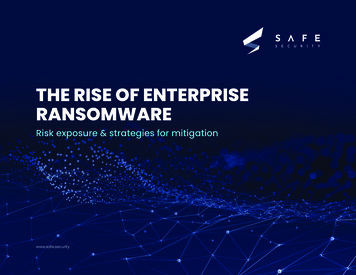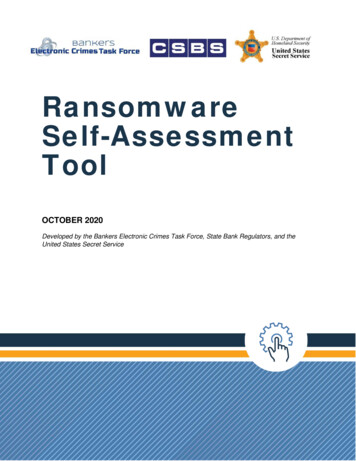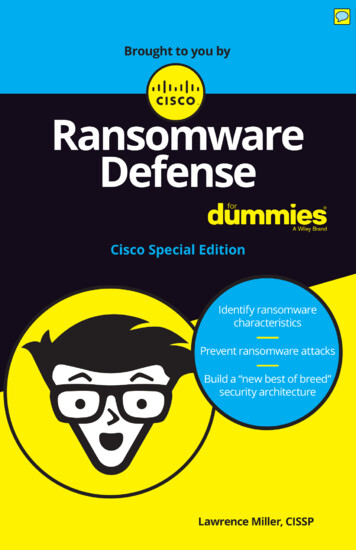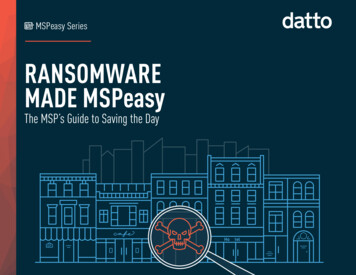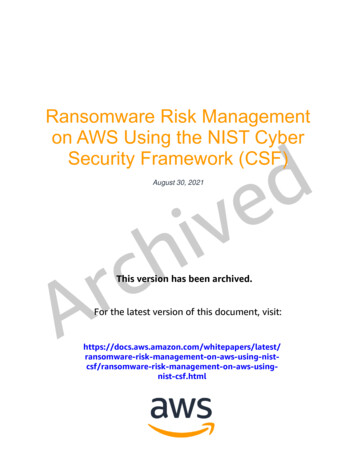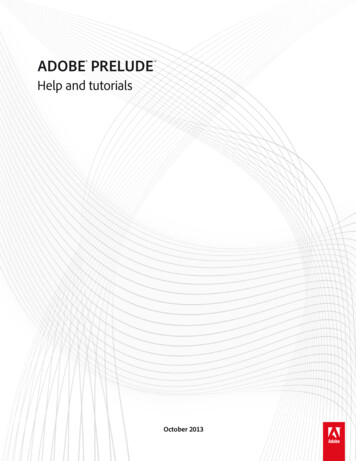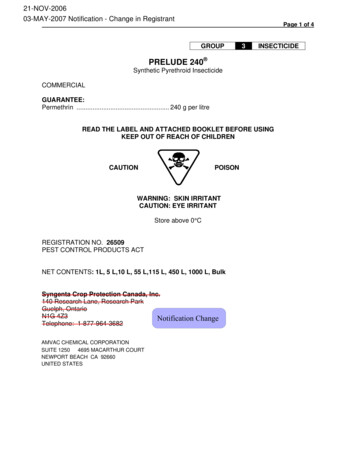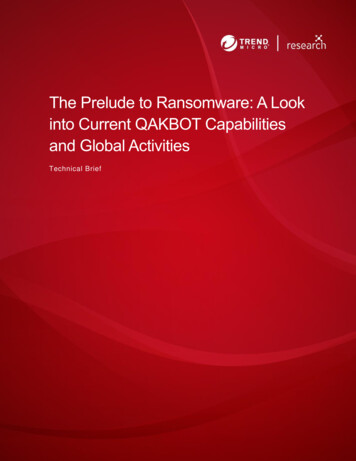
Transcription
The Prelude to Ransomware: A Lookinto Current QAKBOT Capabilitiesand Global ActivitiesTechnical Brief
IntroductionQAKBOT (detected by Trend Micro as TrojanSpy.Win32.QAKBOT) is a modular and highlyevasive information-stealing malware that was first discovered in 2007. This threat is alsoknown as QBOT and PinkSlipbot. Initial versions of QAKBOT targeted financial data and wasclassified as a banking trojan, but more recent versions have acted as a delivery mechanism for“second stage” malware. Specifically, QAKBOT seems to lead to targeted attacks involving datatheft (exfiltration) and ransomware.QAKBOT CapabilitiesThe core QAKBOT loader functionality is extended using a variety of plug-ins. In earlierQAKBOT versions, components were embedded as resources in the main executable. In morerecent versions, the injection DLL, update script, and plug-ins are downloaded by the QAKBOTcore after communicating with the command-and-control (C&C) server. The plug-ins listed hereprovide QAKBOT operators with the functionality needed to achieve their objectives.Plug-inCapabilityWeb-inject modulesEnables theft of sensitive data (usernames, passwords)within browser processesPassword grabber moduleEnables theft of sensitive data from compromisedendpointsCookie grabber moduleEnables the theft of cookies from web browsers (InternetExplorer, Firefox, Chrome, and Microsoft Edge)Email Collector moduleEnables the theft of email threads, which are hijackedand used in follow-on campaignsUniversal Plug and PlayUPnP moduleEnables the use of infected machine as proxies for C&CtrafficLateral Movement moduleEnables propagation inside the infected networkHidden VNC (hVNC) moduleProvides hands on keyboard and lateral movementcapabilities to the operatorsCobalt Strike moduleEnables remote access to the compromised networkwith the Cobalt Strike penetration testing frameworkAtera moduleEnables remote access to the compromised network viaAtera Remote Monitoring Management (RMM) software
QAKBOT Links to Targeted Ransomware AttacksQAKBOT operators are key enablers for ransomware attacks. These operators achieve accessto infected environments through the deployment of Cobalt Strike beacons, which function asstandalone backdoors, or via a Cobalt Strike or Atera RMM plug-in. Since 2019, QAKBOTinfections have led to the eventual deployment of the following human-operated ransomwarefamilies: MegaCortex (2019) Egregor (2020) PwndLocker (2019) Sodinokibi/REvil (2021) ProLock (2020)QAKBOT ActivityThe following is a list of notable events related to QAKBOT, as well as information from TrendMicro Smart Protection Network . Trend Micro has been monitoring this threat for years, andwe have been able to track the spam campaigns linked to QAKBOT operators across the world.While monitoring this malware distribution activity, we found that the top countries targeted werethe United States, Japan, and Germany, while, telecommunications, technology, and educationwere the top industries targeted.DateEventOct 2021Sep 2021The Atera RMM plug-in is discovered.Shathak delivers QAKBOT with malspam.“TR” delivers QAKBOT with malspam.Feb 2021 – Jun 2021Shathak delivers QAKBOT with malspam.Mar 2021QAKBOT infections drop Cobalt Strike.1Mar 2020QAKBOT infections lead to the ProLock Ransomware.Oct 2019QAKBOT infections lead to the PwndLocker Ransomware.May 2019QAKBOT infections lead to the MegaCortex Ransomware.Jun 2018The QAKBOT malware is found on thumb drives manufactured inChina.22007The initial QAKBOT version is discovered.
Figure 1. A global view of QAKBOT activity from March 25, 2021 to October 25, 2021 as seenfrom Trend Micro Smart Protection Network (SPN)Figure 2. The top 10 countries where QAKBOT is distributed
Malware AnalysisThe QAKBOT infection chain usually starts with malicious spam emails and the infectionspreads from there. The stages shown here are typical of QAKBOT but might vary slightly overtime.StageArrival# Description Malicious spam emails with malicious attachment The document uses Excel 4.0 macros and themed social engineering to trickusers into opening the email. The excel document contains Excel 4.0 macrso with a malicious dropperroutine that will download the QAKBOT DLL from a remote server. Social engineering is used to trick the user into “Enabling Content” (macros). Once macros are enabled, the QAKBOT loader DLL is downloaded andexecuted. Persistence is achieved through the installation of registry keys and ascheduled task. The malicious QAKBOT process phones home to the C&C server.4 The C&C server sends additional modules to the infected host .5 Target information is stolen.12Infection3
Postinfection6 Attackers might obtain “hands on keyboard” access to the infectedenvironment following the deployment of a backdoor (such as Cobalt Strike)as a plug-in or as a separate dropped file. Attackers might execute discovery commands to further evaluate theenvironment. Attackers might move laterally from the infected host. In some cases, attackers will deploy ransomware in the environment.Table 1. Illustration and steps of the QAKBOT kill chainQAKBOT Arrival VariationsQAKBOT uses a variety of delivery mechanisms, including different scripting languages andmalicious documents. In the past, QAKBOT has also collaborated with other botnet operators,namely the now defunct Emotet.*Emotet is an example of malware installation as a service, wherein operators install othermalware on their bots for a fee.Figure 3. QAKBOT delivery mechanisms
QAKBOT Malicious Documents and Excel 4.0 MacrosSince late 2020, QAKBOT operators have leveraged malicious Microsoft Excel documents withheavily obfuscated Excel 4.0 macros to evade detection in the initial access phase of the attack.Figure 4. Malicious document delivering QAKBOT (from June 2021 MalSpam Campaign)The primary motivation behind QAKBOT’s (and other malware distributors’) shift toward thisdelivery mechanism can likely be attributed to the lack of support for Excel 4.0 macros in theWindows AntiMalware Scan Interface (AMSI) at that time. Excel 4.0 macro support was onlyadded to AMSI in March 2021, while VBA macro parsing has been supported by AMSI since2018.
QAKBOT Operators’ Use of Hijacked EmailConversationsThe use of hijacked email conversations is a noteworthy technique used by QAKBOTdistributors as a social engineering tactic. In the example shown in Figure 5, an email threadbetween Kelly and Sandy (number 1 in the figure) was stolen during a previous infection by theQAKBOT email collection module. The thread is then reused or hijacked by QAKBOT operators(number 2 in the figure) in a malicious spam campaign. The malicious email appears to comefrom Sandy in reply — but it actually contains the malicious document that drops QAKBOT(number 3 in the figure).The use of hijacked email threads in malicious spam emails is a tactic that was first used by thecybercriminals who operated the now defunct Emotet malware.Figure 5. The hijacked email thread delivering QAKBOT
QAKBOT Infection RoutineFigure 6 shows that the XLSM files contain hidden sheets and an auto open macro (step 1 inthis figure) that executes as soon as the victim opens the document and selects the “EnableContent” button. The macro code evaluates a sequence of formulas that are distributed atvarious indexes (step 2 in this figure) in the document. This is an obfuscation technique that isdesigned to thwart detection using simple strings.Figure 6. The Excel formulas containing malicious code fragmentsFigure 7. Hidden sheets in a QAKBOT XLSM dropperIn the sample in Figure 8, the code generates a unique file name using NOW() (step 1 in thisfigure) to output a timestamp to be used as part of the file name. The dynamic URL formationmakes it harder to block exact URLs. Next, the functions (step 2 in this figure) to be called areresolved and the first of three download attempts from hard-coded hosts begins (step 3 in thisfigure). The downloaded file is stored in the disk as “Post.storg*”. This is the main QAKBOTDLL, which is loaded by “regsvr32 -s” (step 4 in this figure). The QAKBOT main loader DLL isloaded by regsvr32.exe with the -s command.
Figure 8. Analysis of QAKBOT sampleQAKBOT InstallationPacked QAKBOT loader Process hollowingThe main program is unpacked in memory and injected into a new process that started in asuspended state. The injection routine targets the process memory of one of three targets(iexplore.exe, mobsync.exe, or explorer.exe) where the target is unmapped and replaced withthe unpacked QAKBOT loader program. Once the code is injected, QAKBOT callsResumeThread().Figure 9. Process hollowing (UnmapViewOfFile - VirtualAlloc)
Persistence mechanisms and anti-analysis/anti-sandboxroutinesThe loader creates a persistence via a scheduled task using the now deprecated at.exe. Adropped Javascript file creates a scheduled task for persistence for the QAKBOT core. Thesame mechanism is executed when an update is received from the C&C server.Figure 10. Persistence mechanisms through scheduled tasksQAKBOT also includes several routines to detect the presence of security software, and todetect if it is being executed on a virtual machine (VM).Figure 11. Routines to detect if there are security solutions on the device
QAKBOT UPnP: Recruiting new proxies for QAKBOT’sbotnetQAKBOT leverages Simple Service Discovery Protocol (SSDP) to identify other devices on thelocal network. It then parses network device information collected with SSDP to identify internetgateways.Figure 12. QAKBOT leveraging SSDP and parsing information collected with SSDPWith gateways identified, it uses UPnP to create port-forwarding rules on gateway devices toroute traffic from the internet to the infected endpoint. The infected device is then capable ofacting as a Tier 3 proxy in the QAKBOT botnet.Figure 13. UpnP used to create port-forwarding rules
QAKBOT Information Stealing Plug-insOutlook email collectorQAKBOT has been exfiltrating emails from Microsoft Outlook since 2019. The stolen informationis used to enhance the social engineering capabilities of future attacks by spamming emailthread members. QAKBOT extracts emails, parses email headers, and extracts threadrecipients from the address book.Figure 14. The emailcollector dllFigure 15. Invoking the “GetEmailMsgRecipients()” function
Figure 16. Extraction of email address using email regex and CollectOutlookData() function callThe QAKBOT email collector plug-in performs email header parsing to identify interestingheader items. This process includes parsing email authentication results from DomainKeysIdentified Mail (DKIM) signatures and antispam detection results. The email collector modulealso collects data from the Microsoft Outlook address book. After the collection, stolen data isuploaded with HTTPS POST (not FTP as used by QAKBOT for other data exfiltration).Figure 17. Email header parsingFigure 18. The function call to collect address book informationCollectOutlookAddressBookThread()
Figure 19. Function showing the email data exfiltration methodPassword grabber plug-inThe QAKBOT password grabber module can extract credentials (username, password, andhost) from the following applications: Outlook Internet Explorer CuteFTP Firefox ChromePopular browser and email clients are potential targets, and CuteFTP, a rarely used FTP client,is also on the list. There are a few interesting points to note when looking over the list oftargeted applications. For example, we know that QAKBOT uses stolen FTP details for thepurpose of data exfiltration channels. Chrome no longer supports FTP, so malicious actorswould need to grab credentials out of a separate application to steal FTP credentials. Also,QAKBOT uses Network Security Service (NSS) libraries (nss.dll) to interact with Firefoxpassword storage and pilfer credentials from the Firefox SQLite database
Figure 20. The password-grabbing function “plugin passgrabber”Figure 21. CuteFTP password extraction routinesFigure 22. Chrome password extraction routines
Figure 23. Outlook credential extraction routinesFigure 24. Internet Explorer credential extraction routinesFigure 25. QAKBOT using NSS libraries to interact with Firefox
Digital certificate theftQAKBOT is also able to steal digital certificates. It enumerates the installed digital certificateswith CertEnumSystemStore() and extracts both the certificate names and the data.QAKBOT leverages FTP account information stored in the configuration to exfiltrate the stolendata. The FTP accounts are legitimate user accounts that were likely compromised in previousQAKBOT infections. In other words, the domains are not simply malicious domains created forthe sole purpose of harvesting data stolen by QAKBOT.Figure 26. QAKBOT function to steal and exfiltrate stolen data
QAKBOT Campaigns1H 2021 campaign detailsIn the observed campaigns, the threat actors use both “financial” (compensation, overdue debt,rebate) and “business process” (claim, complaint, document) email header lures to entrapvictims.Figure 27. Detection of spam campaign lures from January 2021 to July 2021The attachment name structure consists mainly of LureName RandomNumber Date Code .ext. We show the attachment names we found, as well as when theywere found, in the following table.Campaign dateDate codeAttachment name01192021Complaint Copy 369987483 02182021.xlsFeb 3, 2021Feb 5, 2021Feb 8, 2121Feb 2, 2010Feb 22, 2021Feb 19, 2021
02192021Complaint Letter 21.xls03122021CompensationClaim 1542026698 31272851-05172021.xlsmFeb 23, 2021Mar 6, 2021Mar 8, 2021Mar 13, 2021Mar 13, 2021Mar 14, 2021Apr 17, 2021Apr 16, 2021Apr 19, 2021May 4, 2021May 6, 2021May 10, 2021May 14, 2021May 17, 2021
May 17, 2021Overdue Debt 592550132 06012021.xlsm06022021Document 06022021 1550303392 Copy.xlsm06032021DEBT 06032021 808188295.xlsm0608202162730743159 06082021.xlsm06092021Cancellation Letter 1246498236 06092021.xlsm06142021Rebate 2053672682 06142021.xlsmMay 19, 2021May 19, 2021Jun 1, 2021 Jun 3, 2021Jun 3, 2021Jun 8, 2021Jun 9, 2021Jun 14, 2021Table 2. Email lures used by QAKBOT operators1H 2021 second stage QAKBOT infectionsAfter the initial QAKBOT infection, the operators move onto the second stage or follow-oninfections, which can be attributed to the QAKBOT loader. This table shows the indicators ofcompromise (IOCs) for the second stage infections, as well as descriptions of the files and thedetection timeline.DateFile nameindicatorIOCsMay2021Cobalt Strike 33c82db02274f5C&C server hxxps://restcdn[.]com/ba.css
C&C server IP 195.123.241[.]214Cobalt Strike f9fd06ae38db1fC&C server hxxps://onlineceoshelp[.]com/jquery-3.2.2.min.js hxxps://108.177.235[.]180/strap/j-devmin.jsC&C server IP 108.177.235[.]180Cobalt Strike f2b7c712f60495Mar 2021 Cobalt Strike 4381ed219732505 hxxps://logon.securewindows[.]xyz/ptj hxxps://45.144.29[.]185/cmApr 2021Apr 2021C&C serverTable 3. IOCs for second stage infectionsQAKBOT InfrastructureQAKBOT tiered C&C infrastructureQAKBOT uses a tiered (layered) network of C&C servers, whichmeans that intermediary layers of servers facilitatecommunication with the C&C back end.Tier 1 is the core infrastructure, and is also the botnet backend. Tier 3 proxies relay C&C server communication tothe real C&C servers represented in the diagram as Tier2. Tier 3 proxies get blocked quickly, so they are rotatedin the malware configuration and change frequently.This architecture shields the true location of back-endproxies from security researchers and law enforcement.Here is a list of TCP ports used in C&C communication by theQAKBOT core and plug-ins 22, 80, 443, 995, 1194, 2078, 2087,2222, 3389, 8443, 32100.
QAKBOT C&C infrastructure by autonomous systemWe found that almost 25% of QAKBOT Tier 3 C&C server infrastructure can be associated witha single Autonomous System Number (ASN). ASNs are used by network operators to controlrouting and exchange routing information with other internet service providers (ISPs).ASNPortsPercentage32151194,2078,2087,2222 %422989950.7%1121520780.7%112609950.7%
8 50.2%1135122220.2%3003622220.2%7019950.2%396122 220.2%358199950.2%Table 4. QAKBOT Tier 3 C&C infrastructure
Tactics and TechniquesMitre ATT&CKTacticTechnique (MITRE ID)Initial accessSpear phishing (T1566.001)Spear-phishing link (T1566.002)ExecutionScheduled task(T1053.005)PersistenceRegistry run reys/startup folder(T1547.001)Privilege escalation Scheduled task(T1053.005)Process hollowing(T1055.012)Defense evasionSoftware packing(T1027.002)DLL injection (T1055.001)Code signing(T1553.002)Signed binary proxy execution: regsvr32.exe(T1218.010)Signed binary proxy execution: rundll32.exe(T1218.011)Visualization/Sandbox evasion(T1497.001)Disable or modify tools(T1562.001)Credential accessMan in the browser
(T1185)Lateral movementVNC(T1021.005)CollectionMan in the browser(T1185)C&CMulti-pop proxy(T1090.003)ReferencesISC Handler. (March 3, 2021). SANS ISC InfoSec Forums. “Qakbot infection with CobaltStrike.” Accessed on October 23, 2021, athttps://isc.sans.edu/forums/diary/Qakbot infection with Cobalt Strike/27158/.1Federal Bureau of Investigation. (Aug. 5, 2018). Public Intelligence. “FBI Cyber Bulletin:Identified Qakbot Malware Variant Found on Thumb Drive Manufactured in China.” Accessed onOctober 23, 2021, at https://publicintelligence.net/fbi-qakbot-usb/.2
The core QAKBOT loader functionality is extended using a variety of plug-ins. In earlier QAKBOT versions, components were embedded as resources in the main executable. In more recent versions, the injection DLL, update script, and plug-ins are downloaded by the QAKBOT core after communicating with the command-and-control (C&C) server.



